#The Language of Fashion
Quote
Fashion is the collective imitation of regular novelty; even when it has the alibi of individual expression, or, as we say today, of a 'personality', it is essentially a mass phenomenon in which sociologists are very happy to be interested so long as they find in it the privileged example of a completely pure dialectic between the individual and society.
Roland Barthes, The Language of Fashion
#fashion#novelty#expression#creativity#self#other#dialectic#quotes#Barthes#Roland Barthes#The Language of Fashion
49 notes
·
View notes
Text
communal style.
One of my favorite things are friends and lovers who coordinate their outfits. Sometimes it happens unintentionally so you laugh about it because it means you rubbed off on each other. Other times it's almost like a ritual, that phone call early in the morning or at dusk to ask the other what they're going to wear so they can match or wear complimentary colors, textile, silhouette and layering; the borrowing or exchanging of pieces from each other's closet and jewelry, to the point where you start to lose track of who first owned it, to that unspoken agreement of having joint custody of said pieces; the trial and error of building an outfit, remove and adding elements, standing next to each other to see how it all ties together.
It parallels the dress up games on y8.com (or y3.com or the barbie website); the games you had as a child when you played pretend to be royalty, fairies, whatever occupation your parents had, detectives, zombies, scientists, your favorite cartoon characters. You're living out those memories you had as a child when you sat somewhere in the room as your parents get ready for work or your older siblings get ready for a party, and they asked you for your opinion because kids are impartial and honest. You're reenacting all the montages you saw in chick flicks where girl friends get on the landline and the screen splits in two while they do an outfit check for school, or they have nothing to wear and need advice or to borrow something. This color is in; these shoes are out; this dress looks cute but the weather's too hot; wear this jacket because it can make the look go from day to night and we'll be out all day; I'm bringing an extra outfit just in case; do you still have those earrings I lent you? are you gonna wear them? because i have a necklace that goes with it; can I borrow this scarf?; hair up? -- no, not with that neckline; I can't decide between the boots or the pumps.
It's a partnered or group exercise in quick thinking, an exercise of the chemistry and rhythm in your friendships or relationships. Do you know their favorite color to wear, why they hate this type of pants, why they always have that piece of jewelry they wear with everything, what their go-to is in layering, how they style basics, where their favorite places to shop are, why they love and always buy basically the same pair of shoes that they swear are not the same at all, why they think this is tacky in a bad way and this is tacky in a good way?
Is it a love language in itself? I think so. Sometimes it's more fun to dedicate minutes or hours deciding on a perfect outfit together -- and even by yourself -- than whatever it is you do in a day, paying attention to all the little details that hold esoteric meanings of your self-expressions, adding parts of each other in your expressions. Not everyone can see the effort it took to create the harmony between you but it's there. It's not personal style, it's communal style.
11 notes
·
View notes
Quote
Twit: Uneven or tangled place in yarn, usually occurring in spinning or drawing.
I was hunting through The Language of Fashion for another word and came across this definition. It was news to me, but it makes perfect sense that there would be a word for an annoying tangle in yarn--they are soooooo annoying. And that such a word would be well enough known that it would get turned into a a word for an annoying or stupid person. Mary Brooks Picken wrote The Language of Fashion, the first dictionary by a woman, in 1939 and it was then revised once.
Now, if you ware wondering about drawing, here is the Oxford English Dictionary on that: ”to elongate and attenuate [fibers like cotton or wool] when pulled by hand or passed between successive pairs of rollers revolving at different speeds.” Which now a “rare” term. And certainly not as interesting as twit.
So I guess, I am telling you to go forth and insult people who annoy you but do so with deep historical purpose.
;-)
#fashion history#the language of fashion#fashion dictionary#mary brooks picken#historical insults#insults#twit#Oxford English Dictionary#tangled yarn#yarn#yarn tangles
6 notes
·
View notes
Text

I came across the word "swaggereth" in a book from 1622 last night and felt like it should be shared with the world.
"Hee swaggereth, as though the whole Towne were his owne."
(source: Adagia in Latine and English, Erasmus, 1622.)
#honestly google english men's fashion in the 1620s#he swaggereth deservedly#history#1620s#english language#jacobean#swag#linguistics#things i find while researching other things
8K notes
·
View notes
Text
Someone needs to do an analysis on the way the Kung Fu Panda movies use old-fashioned vs. modern language ("Panda we meet at last"/"Hey how's it going") and old-fashioned vs. modern settings (forbidden-city-esque palaces/modern-ish Chinese restaurant) to indicate class differences in their characters, and how those class differences create underlying tensions and misunderstandings.
#This is neither a criticism nor a compliment of that artistic choice#I just think it's really interesting#Like even looking at the Five:#Tigress talks in an older style than the others because she was mainly raised at the Jade Palace#While Mantis talks like Joe-schmo off the street because he *was* a streetfighter and an ordinary guy#Shifu and even Tai Lung talk like they're from an old-fashioned novel or kung fu movie#Po talks like a modern guy you'd meet working in a twenty-first century family restaurant#Part of Tigress's initial disdain for him in the first movie is clearly because she considers him to be low-class/a commoner#(And therefore an intruder into the world of the Jade Palace and the rest of the Kung Fu masters which appears to be semi-noble).#Shen looks genuinely off-put and disgusted when he has to respond to Po's greeting with a “...hey.”#And when Po wants to appear more legitimate as a warrior he adopts a more “legendary”/old-fashioned way of speaking.#In the aesthetic language of KFP old fashioned=noble/upper class and modern=common/lower class.#This translates entirely naturally—I think especially to an American audience—but it is wild once you notice it#Because you realize: “Hang on—shouldn't *all* these characters be talking like they're living in the medieval era?”#“And what does it mean that they're not? What is the movie attempting to convey with this—probably entirely subconscious—artistic choice?”#kung fu panda
3K notes
·
View notes
Note
Lesbian shirt Tim, when?

Happy pride SHDKFNGM
#RIP JESS#this is ABSOLUTELY how they first met with Tim's 2006 fashion sense you cannot change my mind#ig this is how i do expressions/body language practice in the year of our lord 2024#shitpost#my art#marble hornets#mh#fan art#tim wright#jessica locke#slenderverse
935 notes
·
View notes
Text
Some Chinese fashion styles
Disclaimer: The following styles and their definitions were observed by me and are not authoritative. I am only familiar with Hanfu and if I made mistakes and picked the wrong photo examples or fraud shops, please let me know. Also, this post focused on women's fashion because 1. I am not into men's fashion so I don't know much about them. 2. The algorithm also knew that so I don't really see them.
汉服/Hànfú
传统服饰/Chuántǒng fúshì (传服/chuán fú)
清汉女/Qīng hàn nǚ
旗装/Qí zhuāng
旗袍/Qípáo
新国风/Xīn guó fēng、新中式/Xīn zhōngshì
汉元素/hàn yuánsù
茶艺服/Cháyì fú or 茶服/chá fú
唐装/Tángzhuāng
中山装/Zhōngshānzhuāng.
汉服/Hànfú
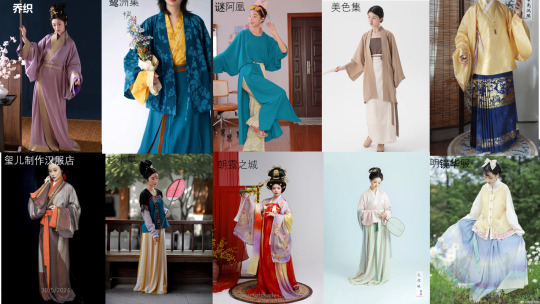
The ethnic clothing of Han Chinese (not the Han Dynasty).
There was a prohibition of Han clothing and hair styles in Qing dynasty, i.e. the 剃发易服/Tìfā yìfú qu Queue Ordinance, so modern hanfu is an on-going revivalist moment.
Modern hanfu are based on archeological evidences with minor twists to suit modern like, such as the type of fabric used and cut.
As a result, there are many types of garments and sub-styles. The figure above shows some examples.
While which style should be included and promoted is a constant debate, but in general, the cutout line is the Qing dynasty (however small accessories such as purses are alright).
传统服饰/Chuántǒng fúshì (传服/chuán fú)
No example because I am not sure who identified with this label.
The Chinese traditional clothing.
This either referred to historical clothing restorers (regardless of ethnicity) or people who promoted that the traditional clothing of Han people should be in the late Ming dynasty style, since "people should get up at where they had fallen".
They might be agreeable with the hanfu movement or not.
清汉女/Qīng hàn nǚ
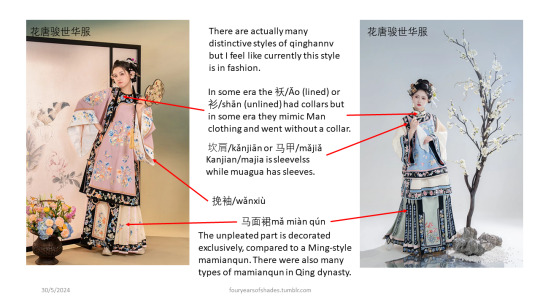
The clothing of women of Han Chinese in the Qing dynasty.
Since the Queue Ordinance wasn't that strictly enforced on Han women, the Han women clothing in the Qing dynasty had quickly absorbed Manchurian's elements while retaining the characteristic two-piece silhouette. (Manchurian women wore a one-piece robe.)
I believed it appeared around 2019 when the styles of hanfu had moved to fully embroidered surface to a more tone down brocade or weaved patterns.
旗装/Qí zhuāng

The ethnic clothing of Man people (Manchurian).
The women's clothing are generally in round collar opened on the left (youren) with straight sleeves.
The most basic item is a 衬衣/chènyī, which doesn't have vents.
However, the most common item I have seen on the street is a 氅衣/chǎng yī (probably rented), which should be worn on top of 衬衣, since they have side vents.
They usually have no standing-up collar but in some cases a fake collar could be worn.
On top of changyi they could wear a 马褂/mǎguà、坎肩/kǎnjiān、褂裥/guà jiǎn.
旗袍/Qípáo
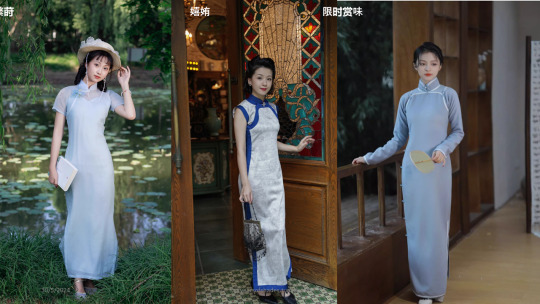
The Chinese clothing of women originated from the Minguo era, known in English as qipao or cheongsam.
The male equivalent is 长衫/chángshān.
Currently in style is the retro-cut, while uses the traditional flat cut (no shoulder seam) instead of the more body-hugging modern draping style.
There are also many variations and cuts, but the overall silhouette is similar.
新国风/Xīn guó fēng、新中式/xīn zhōngshì
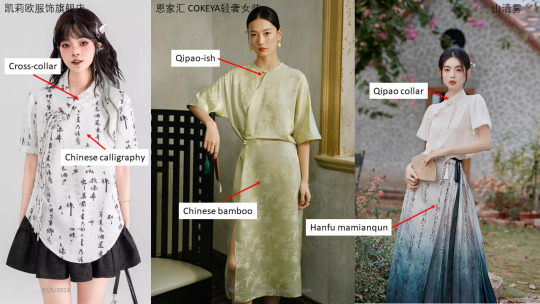
Innovative clothing that was inspired by Chinese traditional aesthetic.
It is an umbrella term.
汉元素/hàn yuánsù refers to clothing inspired by hanfu specifically, while xinguofeng could be inspired by qipao and other ethnic clothing. In addition, hanyuansu is a term more familair to hanfu-ers, so the target audience is slightly different between hanyuansu and xinguofeng.
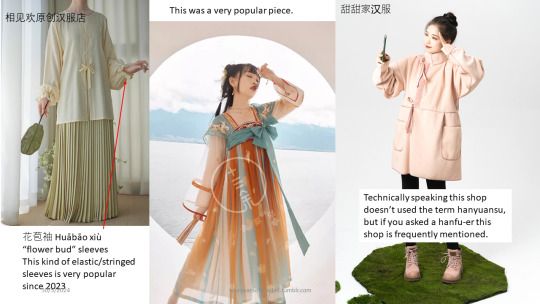
茶艺服/Cháyì fú or 茶服/chá fú,i.e tea dress, which aimed to convey a zen and rustic aesthetic could also be considered a sub-style. They are often worn by retirees, artists or workers in tea shops, calligraphy shops, Chinese spas, Chinese traditional medicine clinics etc.

The older "Chinese style" generally refers to 唐装/Tángzhuāng and 中山装/Zhōngshānzhuāng.
Tangzhuang (Tang Suit) was a men suit characterized with a mandarin collar with a row of 盘扣/pán kòu frogs in the middle. There are two pockets at the bottom front of the suit. It was a well-known looked worldwide due to the 2001 APEC summit. However, other clothes resembled a 马褂/mǎguà could also be called a tangzhuang.
Zhongshanzhuang was designed and named after Sun Yat-sen but was often known in English as the Mao Suit. Mao Suit was characterised with a 关门领/Guānmén lǐng(“closed-door collar", but also known as Mao collar in English) with a row of round buttons. There are four pockets at the front of the suit.
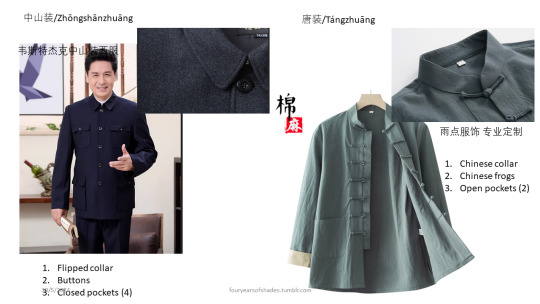
中华lolita/Zhōnghuá lolita
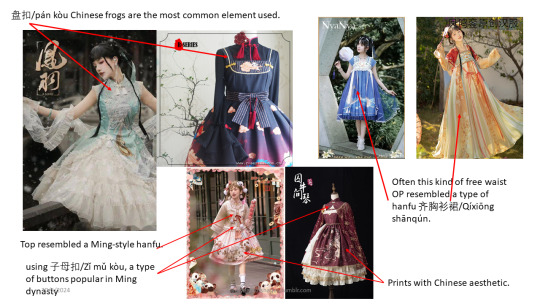
A sub-style of the lolita fashion inspired by cheongsam/qipao, hanfu or other Chinese artistic elements.
The same item could appeared in different styles, but with different cut and accessories. The following examples showed a mamianqun used in different styles.

THE END
#chinese fashion#hanfu#qinghannv#qipao#qizhuang#chinese language#non-hanfu#lolita fashion#terminology#i rarely seen men in alternate fashion#like i saw maybe one in the last year#they spent money elsewhere#like shoes#long post#reference#fouryearsofshades#i spent so much time on this post#hope you will like it#feel free to correct me if i am not right
535 notes
·
View notes
Text

hot girl summer 🔥
open for better quality | no reposts
#ais#ais ts#ais touchstarved#touchstarved game#heatstroke redraw#fanart#myart#doodle#in incredibly predictable fashion i have fallen for the guy with very specific character design traits#and i find it so cute how he likes learning languages and secretly likes having thoughtful things done for him#i know he's a softie even though it only shows w/ the tamed soulless hahaha#i've been wanting to do this trend bc i don't render muscles as well as i'd like to ;;#so this was a fun challenge and i'm happy w/ how it turned out!!#i am also slightly afraid to crosspost this on my other socials LOL
300 notes
·
View notes
Text
my problem is that many people consider fashion and linguistics as second class topics and not as social contracts intrinsically linked to human beings as a whole. for them they are just things when they are actually systems of looking at the world and the direct response of history. language is the mirror of society, fashion is the mirror of people and neither gets the recognition it deserves.
186 notes
·
View notes
Text









Kwaidan (1964)
Directed by Masaki Kobayashi
Cinematography by Yoshio Miyajima
#art#art history#artists on tumblr#aesthetic#film photography#beautiful photography#film#movie#cult film#kwaidan#kobayashi#masaki kobayashi#japan#japanese art#japanese#japanese culture#japanese language#painting#japanese movie#japanese film#japanese folklore#japanese flower#japanese fashion#asian art#asian movie#asian film#60s art#60s#60s movies#60s film
222 notes
·
View notes
Text
Hallo mein Name ist Ebenholz Dunkel'heit Demenz Raben Weg und ich habe langes ebenholz-schwarzes Haar (so habe ich meinen Namen gekriegt) mit lila Strähnen und roten Spitzen das bis zur Mitte meines Rückens geht und eisblaue Augen wie durchsichtige Tränen und viele Leute sagen mir, dass ich wie Alma Unterwindseite aussehe (A. d. A.: wenn du nich weist wer sie ist dann verpiss dich von hier!). Ich bin nicht mit Gerhard Weg verwandt, aber ich wünschte ich wäre es, weil er ein verdammt heißer Feger ist. Ich bin ein Vampir, aber meine Zähne sind gerade und weiß. Ich habe blasse weiße Haut. Ich bin auch eine Hexe, und ich gehe auf eine Zauberschule namens Schweinwarzen in England, wo ich in der siebten Jahrgangsstufe bin (ich bin siebzehn). Ich bin ein Grufti (falls das euch nicht klar war) und ich trage vor allem schwarz. Ich liebe Heißes Thema und kaufe dort alle meine Klamotten. Heute zum Beispiel trug ich ein schwarzes Korsett mit passender Spitze drum herum und einen schwarzen Leder-Minirock, rosa Netzstrümpfe und schwarze Springerstiefel. Ich trug schwarzen Lippenstift, weiße Grundierung, schwarzen Augenkonturenstift und roten Lidschatten. Ich ging aus Schweinwarzen raus. Es schneite und regnete, also war keine Sonne da, worüber ich sehr glücklich war. Viele Popper starrten mich an. Ich zeigte ihnen den Stinkefinger.
#my only contribution to#speak your language day#enjoy#spyld#german#german stuff#deutsch#deutsches zeug#scheißpfosten#my immortal#...mein unsterbliches???#i deliberately went for the most german words i could find. like i'm the german academie française#ive never heard anyone say 'augenkonturenstift' for eyeliner before but i found it on google and its annoyingly german soooo#translating 'preps' was surprisingly difficult so i had to do some digging. the popper subculture is from the 80s so not quite the right#time period but in terms of fashion and general attitude they were actually really similar to american preps#love how i'm annotating this like it's an academic translation and not a silly shitpost
2K notes
·
View notes
Quote
Dandyism is not only an ethos (on which much has been written since Baudelaire and Barbey) but also a technique. It is these two together which make a dandy, and it is obviously the latter which guarantees the former, as with all ascetic philosophies (of the Hindu type, for example) in which a physical form of behaviour acts as a route towards the performance of thought...
Roland Barthes, The Language of Fashion
50 notes
·
View notes
Text
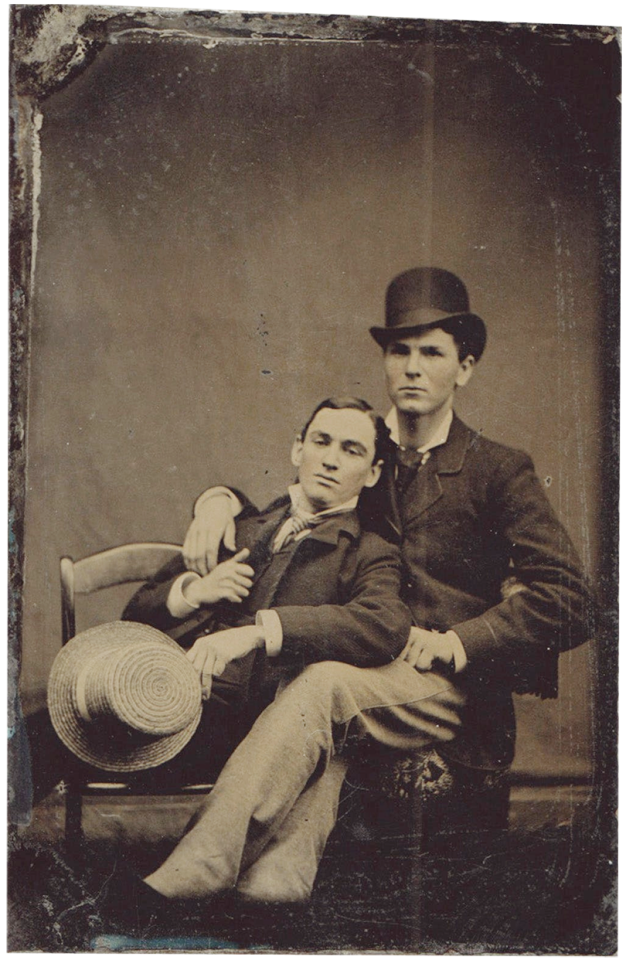
Tintype of a handsome pair, the man in front leaning cozily back into his companion's embrace, c. 1875-1880
#love the contrast between the rather reserved expressions and the very relaxed and even playful body language#interestingly this guy seems to be missing a portion of his left pinky finger#brightened for tumblr—refer solely to seller's pic if buying#19th century#1800s#1870s#19th century fashion#1870s fashion#men's fashion#menswear#fashion history#historical fashion#historical dress#19th century photography#tintype#ferrotype#19th century men#vintage men#gay interest
875 notes
·
View notes
Note
Please can you explain the difference of meaning between hanfu and huafu ? Sorry if you already got the question
Hi, thanks for the question, and sorry for taking ages to reply! (hanfu photo via)
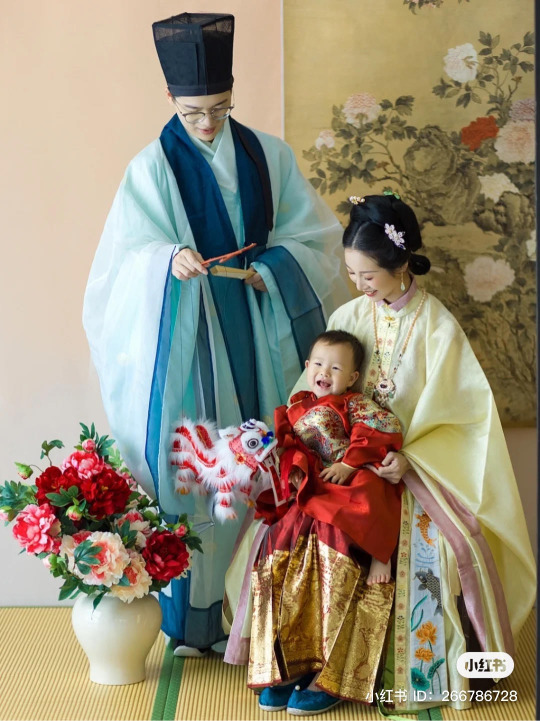
The term “hanfu” (traditional Chinese: 漢服, simplified Chinese: 汉服) literally means “Han clothing”, and refers to the traditional clothing of the Han Chinese people. “Han” (漢/汉) here refers to the Han Chinese ethnic group (not the Han dynasty), and “fu” (服) means “clothing”. As I explained in this post, the modern meaning of “hanfu” is defined by the hanfu revival movement and community. As such, there is a lot of gatekeeping by the community around what is or isn’t hanfu (based on historical circumstances, cultural influences, tailoring & construction, etc). This isn’t a bad thing - in fact, I think gatekeeping to a certain extent is helpful and necessary when it comes to reviving and defining historical/traditional clothing. However, this also led to the need for a similarly short, catchy term that would include all Chinese clothing that didn’t fit the modern definition of hanfu -- enter huafu.
The term “huafu” (traditional Chinese: 華服, simplified Chinese: 华服) as it is used today has a broader definition than hanfu. “Hua” (華/华) refers to the Chinese people (中华民族/zhonghua minzu), and again “fu” (服) means “clothing”. It is an umbrella term for all clothing that is related to Chinese history and/or culture. Thus all hanfu is huafu, but not all huafu is hanfu. Below are examples of Chinese clothing that are generally not considered hanfu by the hanfu community for various reasons, but are considered huafu:
1. Most fashions that originated during the Qing dynasty (1644–1911), especially late Qing, including the Qing aoqun & aoku for women, and the Qing changshan and magua for men. I wrote about whether Qing dynasty clothing can be considered hanfu here. Tangzhuang, which is an updated form of the Qing magua popularized in 2001, can also fit into this category. Below - garments in the style of Han women’s clothing during the Qing dynasty (清汉女装) from 秦綿衣莊 (1, 2).
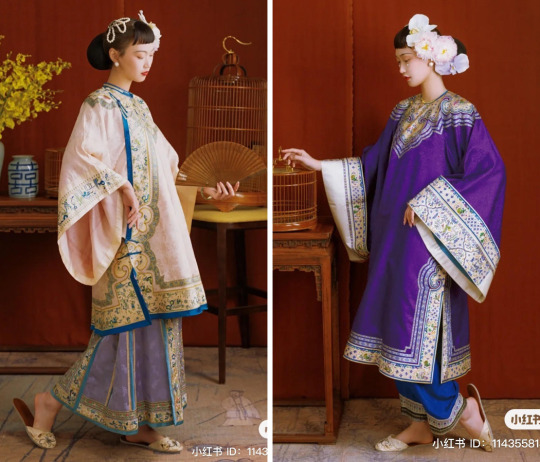
2. Fashions that originated during the Republican era/minguo (1912-1949), including the minguo aoqun & aoku and qipao/cheongsam for women, and the minguo changshan for men (the male equivalent of the women’s qipao). I wrote about why qipao isn’t considered hanfu here. Below - minguo aoqun (left) & qipao (right) from 嬉姷.

Below - Xiangsheng (crosstalk) performers Zhang Yunlei (left) & Guo Qilin (right) in minguo-style men’s changshan (x). Changshan is also known as changpao and dagua.
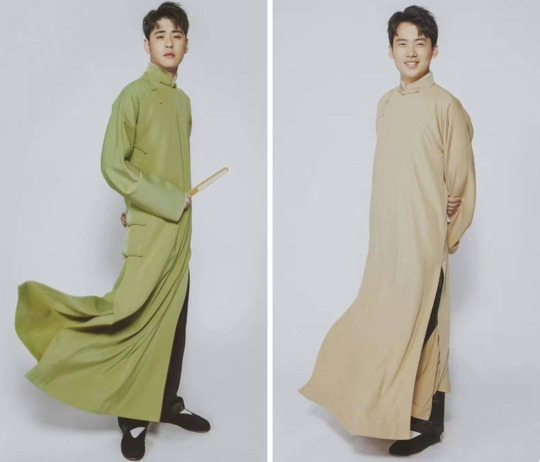
3. Qungua/裙褂 and xiuhefu/秀禾服, two types of Chinese wedding garments for brides that are commonly worn today. Qungua originated in the 18th century during the Qing dynasty, and xiuhefu is a modern recreation of Qing wedding dress popularized in 2001 (x). Below - left: qungua (x), right: xiuhefu (x).
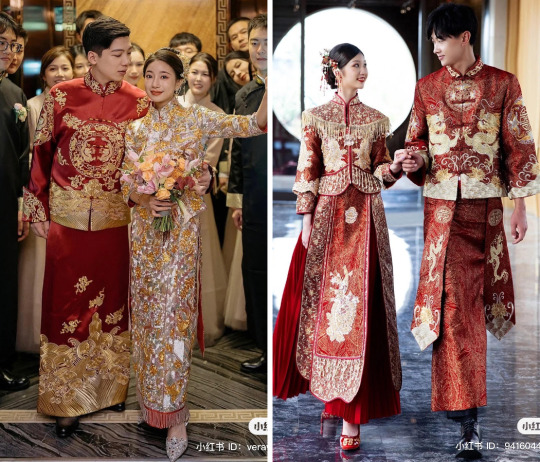
4. Modified hanfu (改良汉服/gailiang hanfu) and hanyuansu/汉元素 (hanfu-inspired fashion), which do not fit in the orthodox view of hanfu. Hanfu mixed with sartorial elements of other cultures also fit into this category (e.g. hanfu lolita). From the very start of the hanfu movement, there’s been debate between hanfu “traditionalists” and “reformists”, with most members being somewhere in the middle, and this discussion continues today. Below - hanyuansu outfits from 川黛 (left) and 远山乔 (right).

5. Performance costumes, such as Chinese opera costumes (戏服/xifu) and Chinese dance costumes. These costumes may or may not be considered hanfu depending on the specific style. Dance costumes, in particular, may have non-traditional alterations to make the garment easier to dance in. Dunhuang-style feitian (apsara) costumes, which I wrote about here, can also fit into this category. Below - left: Chinese opera costume (x), right: Chinese dance costume (x).
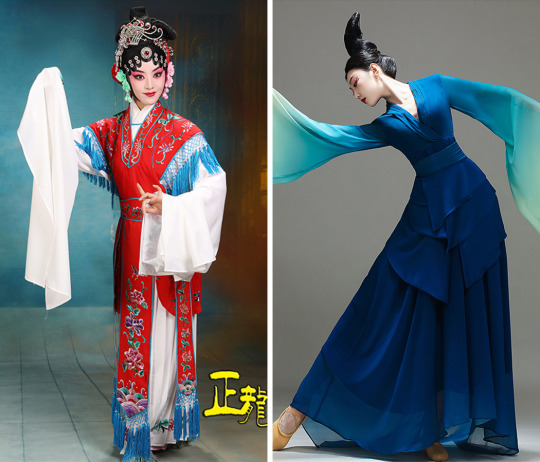
6. Period drama costumes and fantasy costumes in popular media (live-action & animation, games, etc.), commonly referred to as guzhuang/古装 (lit. “ancient costumes”). Chinese period drama costumes are of course based on hanfu, and may be considered hanfu if they are historically accurate enough. However, as I wrote about here, a lot of the time there are stylistic inaccuracies (some accidental, some intentional) that have become popularized and standardized over time (though this does seem to be improving in recent years). This is especially prevalent in the wuxia and xianxia genres. Similarly, animated shows & games often have characters dressed in “fantasy hanfu” that are essentially hanfu with stylistic modifications. Below - left: Princess Taiping in historical cdrama 大明宫词/Palace of Desire (x), right: Wei Wuxian and Lan Wangji in wuxia/xianxia cdrama 陈情令/The Untamed (x).

7. Any clothing in general that purposefully utilizes Chinese style elements (embroidery, fabrics, patterns, motifs, etc). Chinese fashion brand Heaven Gaia is a well-known example of this. Below - Chinese-inspired designs by Heaven Gaia (x).
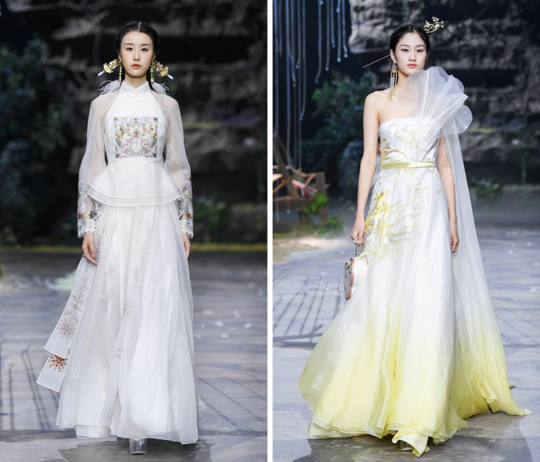
8. Technically, the clothing of China’s ethnic minorities also fit under the broad definition of huafu, but it’s rarely ever used in this way.
From personal observation, the term “huafu” is mainly used in the following situations:
1. Some large-scale events to promote Chinese clothing, such as the annual “华服日/Huafu Day”, will use “huafu” in their name for inclusivity.
2. For the same reason as above, Chinese clothing including hanfu will often be referred to as “huafu” on network television programs (ex: variety shows).
3. A few Chinese clothing shops on Taobao use “huafu” in their shop name. Two examples:
明镜华服/Mingjing Huafu - sells hanfu & hanyuansu.
花神妙华服/Huashenmiao Huafu - sells Qing dynasty-style clothing.
With the exception of the above, “huafu” is still very rarely used, especially compared to “hanfu”. It has such a broad definition that it’s just not needed in situations for which a more precise term already exists. However, I do think it’s useful as a short catch-all term for Chinese clothing that isn’t limited to the currently accepted definition of hanfu.
If anyone wants to add on or correct something, please feel free to do so! ^^
Hope this helps!
#happy 2023!#hanfu#huafu#terminology#language#hanfu movement#history#reference#ask#reply#>1000#chinese fashion#chinese culture#china
2K notes
·
View notes
Text
what I was talking abt earlier. we have fully looped back around and away from feminism, societally, whereas before it was very Feminism 101 to acknowledge that many parts of existing as a woman in a misogynistic society are painful and upsetting.
not that being a woman is Inherently Negative in a bubble. but that living on this earth, in the conditions we're living in, is hostile to women.
and that gender is a performance. that many of the Staples Of Femininity as accepted by society are things that you have to create and perform and mold artificially and aren't inherent, that COMPLAINING about day to day difficulties of existing as a woman is something that you're allowed to do.
acknowledging these basic, again, feminism 101 things, that something tied to womanhood is more time consuming or more expensive or more dangerous Because Of The Problems. does not CREATE the problems. that when women complain about having to perform femininity, they are not, in fact, oppressing themselves. the call does not come from inside the fucking house.
saying that you HAVE suffered does not fucking equate that you believe you SHOULD have suffered.

like I could talk about this for hours. how braindead and one-dimensional the Takes are getting. "being a woman is looking in the mirror and going fuck yeah i'm a woman" damn. I guess any negative experiences you have by living in a misogynistic world... are your fault if you are anything but positive?
"you don't actually want liberation" we've fully gone back to telling feminists "you WANT to be oppressed" when anything negative about our society is pointed out. it's not real until I say it out loud, I guess, and then I'm actually the one who caused it.
if anybody expresses any unhappiness with how they're treated or the status quo or the language and culture surrounding womanhood and femininity. they've created it, right that second. they invented it just now. it wasn't a problem before somebody complained, right?
also trans women aren't braindead zombies who just follow the flow of whatever cis women around them say. I am pretty fucking sure they are very much aware of pain, and are MORE than aware of the swirling torrent of misogyny and standards of femininity than anybody else. actually. and I am pretty sure someone complaining on tumblr that being a woman means always putting on a performance is going to make someone change their mind about transitioning. also "performing femininity" as a necessity to being treated well as a woman is not fucking NEWS to your Local Trans Woman. I AM PRETTY SURE SHE GETS THE CONCEPT. using trans women as a scapegoat for this braindead perspective on gender politics is spineless, meritless, and pathetic.
#how I feel about my gender is not the same as how I feel about the living conditions of my gender#when I saw that post I screenshotted here I literally sat w my mouth open for a minute#sent it to my friends and was like am I fucking crazy. is this what we're doing now#Forced Positivity and that there is no war in ba sing se and actually#you're ruining children's lives if you complain about misogyny on twitter#I don't HAVE to tell little girls about the downsides because they are already being mistreated#before they have even heard the word 'misogyny' let alone know what it means#you do not have to be fucking happy all the time about the cards you're dealt.#you don't live in a bubble where it's just you and your mirror and your pretty dress and nothing bad has ever happened to you#unfortunately bitch. we will have negative experiences that are in fact. part of the package of being a woman#and IGNORING them doesn't make them not exist. actually they will continue to remain status quo unless acknowledged#sergle.txt#I see so much rhetoric that is JUST old-fashioned gender ideals being presented with liberal language on tiktok#that is just telling women that womanhood is just being a girllll and loving pretty things and being kind and gentleeeee and nurturing#and not working and just like being wholesome and being happy and being a light in ppl's lives and just LOVING LOVING LOVING being a woman#so if for even one second. you don't love it. you are actually failing at being a woman#if you complain about the standards for shaving or putting on makeup. which used to be Baby's First Feminism online#that's actually just you creating problems. you're not supposed to acknowledge it. you're supposed to shut up and smile into the mirror.
231 notes
·
View notes
Text




me in my wedding dress, my drawings based on the hairstyle and bouquet I had imagined (and that's what I looked like later — I wore my wreath during the nuptials in church) 💐💐💐
#illustration#love illustration#wedding#wedding dress#wedding gown#bridal#bridal fashion#bride#wedding planning#wedding inspiration#wedding ideas#handmade#couple goals#in love#love life#i love him#lovers#love language#art#nuptials#wedding art
56 notes
·
View notes